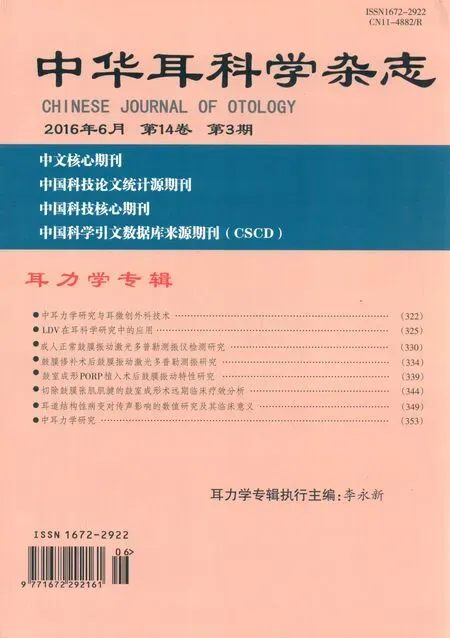135例听力障碍大学生聋病易感基因检测结果分析
潘蕾 陈亚秋 刘瑾 刘宏彦天津市妇女儿童保健中心(天津300070)
135例听力障碍大学生聋病易感基因检测结果分析
潘蕾陈亚秋刘瑾刘宏彦
天津市妇女儿童保健中心(天津300070)
【摘要】目的对听力障碍大学生进行聋病易感基因检测,了解常见聋病易感基因四个基因20个位点的突变情况,为耳聋的防治提供依据。方法应用基质辅助激光解析离子飞行时间质谱技术,通过采集末梢血检测135例听力障碍大学生的GJB2、GJB3、SLC26A4和线粒体12SrRNA基因的20个突变位点。结果135例受检者中77例存在基因突变,突变率为57.04%;杂合突变23例,纯合突变34例,复合杂合突变20例。c.235delC突变占GJB2基因突变的91.11%(41/ 45);c.IVS7-2A>G突变占SLC26A4基因突变的79.31%(23/29);12SrRNA基因仅检出3例m.1555A>G同质性突变;GJB3基因检出c.547G>A杂合突变1例。结论135例受检者中GJB2、GJB3、SLC26A4和线粒体12SrRNA基因突变率为57.04%;c.235delC是GJB2基因的常见突变位点;c.IVS7-2A>G是SLC26A4基因的常见突变位点;检出少数与氨基糖苷类药物耳毒性密切相关的线粒体12SrRNA基因突变;GJB3基因突变率不高。通过对听力障碍人群进行聋病易感基因检测,从分子诊断水平明确病因,进行耳聋靶向预防突变和遗传咨询,提高优生优育。
【关键词】耳聋;聋病易感基因;基因突变;遗传咨询
听力障碍是人类常见的致残疾病之一,发病率在1~3‰。2006年第二次全国残疾人抽样调查[1]推算我国现有听力残疾2004万人,患病率2.11%,其中单纯听力残疾患病率1.52%。由于50~70%的听力障碍与遗传因素有关[2,3],对育龄听力障碍人群进行聋病易感基因检测,既是基因学诊断,又可从遗传角度对听力障碍防控,降低其后代致残发生率。本文检测135例听力障碍大学生的聋病易感基因突变报告如下。
1 资料与方法
1.1研究对象
2015年正就读于天津某理工大学聋人工学院的135名听力障碍大学生,其中男生67人,女生68人,年龄最小18岁,最大27岁,平均21.17±1.747岁。所有学生了解本次检测的目的、方法,且自愿参加,并填写知情同意书。135人均持有当地残疾人联合会发放的《听力障碍残疾证》,无其他残疾,智力正常。
1.2研究方法
1.2.1标本采集
采集末梢指血于滤纸片上,避免污染,充分晾干,单片装袋,低温保存。
1.2.2检测方法
由华大基因检验所利用基质辅助激光解析离子飞行时间质谱技术,检测四个聋病易感基因[4-6]的20个位点,分别是GJB2基因(c.235delC,c.35delG,c.167delT,c.299_300delAT,c.176_191dell6)、GJB3基因(c.538C>T,c.547G>A)、SLC26A4基因(c.281C>T,c.589G>A,c.IVS7-2A>G,c.1174A>T,c.1226G >A,c.1229C>T,c.IVS15+5G>A,c.1975G>C,c.2027T>A,c.2162C>T,c.2168A>G)、线粒体12SrRNA基因(m.1555A>G,m.1494C>T)。
1.3统计学分析
采用SPSS16.0统计软件分析数据,不同性别突变率的差异采用χ2检验,P<0.05为差异有统计学意义。
2 结果
2.1135名受检者中不同程度的基因突变77例,突变率57.04%。杂合突变23例,纯合突变34例,复合杂合突变20例,见表1。男生43例,女生34例,突变在性别上无统计学意义(χ2=2.769,P=0.096)。
2.277例基因突变个体中21例携带两个位点突变,其中2例出现在不同基因位点上,c.235delC杂合突变/ c.IVS7-2A>G纯合突变1例,c.176_191del16杂合突变/ c.IVS7-2A>G杂合突变1例。
2.3GJB2基因突变44例,占总受检人数的32.59% (44/135)。c.176_191del16杂合突变1例、纯合突变1例;c.235delC杂合突变13例、纯合突变19例;c.299_ 300delAT杂合突变1例;c.176_191del16/ c.235delC复合杂合突变1例;c.235delC/ c.299_300delAT复合杂合突变8例。
2.4GJB3基因突变1例,占总受检人数的0.74%(1/ 135),即c.547G>A杂合突变。
2.5线粒体12SrRNA基因突变3例,占总受检人数的2.22%(3/135),均为m.1555A>G同质性突变。
2.6SLC26A4基因突变27例,占总受检人数的20%(27/135)。c.IVS7-2A>G杂合突变4例、纯合突变10例;其余是杂合突变,分别为c.589G>A位点2例、c.IVS15+5G>A位点1例、c.1174A>T/ c.2168A>G复合杂合1例、c.1174A>T/ c.IVS7-2A>G复合杂合1例、c.1226G>A/ c.2168A>G复合杂合1例、c.1229C>T/ c.2168A>G复合杂合1例、c.1229C>T/ c.IVS7-2A>G复合杂合1例、c.1975G>C/ c.IVS7-2A>G复合杂合1例、c.2162C>T/ c.IVS7-2A>G复合杂合1例、c.2168A>G/ c.IVS7-2A>G复合杂合3例。
3 讨论
大部分听力障碍与遗传因素有关,通过对聋病易感基因的研究,目前已有100多个非综合征型耳聋基因座位定位,60多个基因被克隆或鉴定。据梁爽、李海波等[7-10]报道,GJB2、GJB3、SLC26A4、线粒体12SrRNA四个基因在中国聋人中所占耳聋比例是42~49%。本次检测135名听力障碍大学生的聋病易感基因突变率57.04%,突变发生率亦较高。基因突变的受检者中,54例纯合突变和复合杂合突变考虑与遗传因素有关,占总数的40%;23例单杂合突变,由于无家族史情况,不能确定其是否与遗传因素有关。
3.1GJB2基因
GJB2基因是最常见的聋病易感突变基因,与先天性重度耳聋有关。各国的GJB2突变率不同,代志瑶[11]报道我国占20.05%。本次检测的GJB2基因突变率最高,占32.59%;其中c.235delC突变占GJB2基因突变的91.11%(41/45),未发现c.35delG突变,这与文献[12-18]中报道的我国人群中该基因突变最多的位点是c.235delC相符。
3.2GJB3基因
GJB3基因与高频听力下降有关,属于常染色体显性或隐性遗传,可导致进行性或迟发型中度至极重度耳聋,其突变率不高[8,19,20],本次仅检测出1例。
3.3SLC26A4基因
SLC26A4基因是临床常见的大前庭水管综合征的致病基因,婴儿出生时听力正常,在感染或颅脑外伤等因素作用下可导致听力下降,应避免引起听力下降的高危因素,防止耳聋或耳聋加重。c.IVS7-2A>G是常见的SLC26A4基因突变位点[21,22],本次检测到的c.IVS7-2A>G突变占SLC26A4基因突变的79.31%(23/29)。
3.4线粒体12SrRNA
线粒体12SrRNA与氨基糖苷类药物的耳毒性密切相关,属母系遗传。本次受检者中仅有3例为此基因的m.1555A同质性突变,低于郭玉芬等[23]报道的9.50%。这部分受检者及家庭成员应终生不使用氨基糖苷类药物,避免“一针致聋”的发生,其家庭母系成员的婚育须进行遗传咨询。

表1 基因位点突变的检出情况[例(%)]Table 1 Detection of gene mutations[Cases(%)]
3.5GJB2和SLC26A4基因
GJB2和SLC26A4基因为常染色体隐性遗传,子代为纯合或复合杂合突变才表现出耳聋,本次检测的听力障碍学生中有21例杂合突变,则可能存在20个位点之外的基因位点突变。
同证婚配可增加遗传发生几率已成为共识,目前我国听力障碍人群在聋哑学校或福利机构中呈同证聚集状态[24],聋人之间存在普遍的同证婚配情况,对育龄聋人及其配偶的聋病易感基因检测和干预可减少下一代聋儿的出生,降低出生缺陷。由于基因具有地区、种族等差异性,通过对中国听力障碍人群的聋病易感基因检测,实现基因学诊断,尽可能揭示病因的同时,有针对性利用三级疾病预防降低聋儿的出生,提高优生优育。婚前检测聋病易感基因,遗传咨询、指导恋爱婚配和靶向预防;孕后对胎儿进行基因检测;产后即新生儿听力筛查和聋病易感基因检查。
通过本研究,对已检出耳聋致病基因的受检者,应避免同一基因突变者之间婚配。对未检出耳聋致病基因的受检者,可能是非遗传因素所致,但不能排除其存在20个位点以外的突变基因。纯合或复合杂合突变受检者,在明确基因学病因诊断后,对其后期进行遗传咨询、怀孕风险评估等具有非常重要的指导意义。对聋病易感基因携带者,有必要通过进一步的基因诊断来明确其是否存在其他致病基因或位点,亦或许可为单杂合突变致聋的研究提供依据。本次检测为基因正常的受检者,在除外环境因素外,仍有必要全基因测序,随着基因检验技术的不断提高,或许可发现新的耳聋致病基因和新位点,为今后更深入的基因学研究提出新的课题。
参考文献
1孙喜斌,魏志云,于丽玫,等.中国听力残疾人群现状及致残原因分析[J].中华流行病学杂志,2008,29(7):643-646.Xibin Sun,Zhiyun Wei,Limei Yu,et al.Prevalence and etiology of people with hearing impairment in China[J].Chinese Journal of Epi⁃demiology,2008,29(7):643-646.
2BirkenhagerR,AschendorffA,SchipperJ,et al.Nonsyndromic hered⁃itary hearing impairment[J].Laryngorhinootologie,2007,86(4):299-309.
3Petit C.Memorial lecture-hereditary sensory defects:from genes to pathogenesis[J].American journal of medical genetics Part A,2004,130A(1):3-7.
4戴朴,于飞,韩冰,等.中国不同地区和种族重度感音神经性聋群体热点突变的分布和频率研究[J].中华耳鼻喉头颈外科杂志,2007,42(11):804-808.Pu Dai,Fei Yu,Bing Han,et al.Features of nationwide distribution and frequency of a common gap junction beta-2 gene mutation in China[J].Chinese Journal of Otorhinolaryngology Head and Neck Surgery,2007,42(11):804-808.
5赵亚丽,王秋菊,李庆忠,等.95例前庭水管扩大核心家系SLC26A4基因特异突变图谱[J].听力学及言语疾病杂志,2008,16 (3):171-177.Yali Zhao,Qiuju Wang,Qingzhong Li,et al.A Distinct Spectrum of SLC26A4 Mutations in 95 Nuclear Families Associated with En⁃larged Vestibular Aqueduct[J].Journal of Audiology and Speech Pa⁃thology,2008,16(3):171-177.
6管敏鑫,赵立东.与氨基糖甙类抗生素耳毒性相关的线粒体12SrRNA突变的流行病学特征[J].中华耳科学杂志,2006,4(2):98-105.Minxin Guan,Lidong Zhao.Mitochondrial DNA mutations associated with aminoglycoside ototoxicity[J].Chinese Journal of Otology,2006,4(2):98-105.
7Xia JH,Liu CY,Tang BS,et al.Mutations in the gene encoding gap⁃junction protein beta-3 associated with autosomal dominant hear⁃ingimpairment[J].Nature genetics,1998,20(4):370-373.
8梁爽,孙喜斌,韩睿,等.非综合征型聋患者耳聋相关基因检测结果分析[J].听力学及言语疾病杂志,2011,19(1):10-13.Shuang Liang,Xibin Sun,Rui Han,et al.Deafness Gene Mutations Analysis in Cases with Non-syndromic Deafness[J].Journal of Audi⁃ology and Speech Pathology,2011,19(1):10-13.
9李海波,李琼,李红,等.非综合征性聋突变热点的流行病学分析[J].临床耳鼻咽喉头颈外科杂志,2012,26(13):589—594.Haibo Li,Qiong Li,Hong Li,et al.A literature review of epidemio⁃logical studies on mutation hot spots of Chinese population with non-syndromic hearing loss[J].Journal of Clinical Otorhinolaryn⁃gology Head and Neck Surgery(China),2012,26(13):589—594.
10邹凌,蔡娟,杨馨婷,等.52例听力损失儿童及其父母耳聋基因芯片筛查结果分析[J].中国听力语言康复科学杂志,2014,12(3):178-181.Ling Zou,Juan Cai,Xinting Yang,et al.Application of DNA Microar⁃ray for Screening Deafness-related Genes in 52 Children with Non⁃syndromic Sensorineural Hearing Loss and Their Parents[J].Chi⁃nese Scientific Journal of Hearing and Speech Rehabilitation,2014,12(3):178-181.
11代志瑶,孙宝春,黄莎莎,等.GJB2基因听力学表型与基因型关系分析[J].中华耳科学杂志,2014,12(1):34-36.Zhiyao Dai,Baochun Sun,Shasha Huang,et al.Audiological Fea⁃tures/Genotype Correlations in GJB2 Mutation[J].Chinese Journal of Otology,2014,12(1):34-36.
12王秋菊.新生儿聋病易感基因筛查的意义和策略[J].中国医学文摘耳鼻咽喉科学,2007,22(1):21-22.Qiuju Wang.The meaning and strategy of neonatal deaf disease sus⁃ceptibility gene screening[J].Chinese ENT News and Reviews,2007,22(1):21-22.
13Wang QJ,Zhao YL,Rao SQ,et a1.A distinct spectrum of SLC26A4 mutations in patients with enlarged vestibular aqueduct in China[J].Clin Genet,2007,72(3):245-254.
14戴朴,于飞,刘新,等.18个省市聋校学生非综合征性聋病分子流行病学研究(I)—GJB2 235delC和线粒体DNA 12SrRNA A1555G突变筛查报告[J].中华耳科学杂志,2006,4(1):1—5.Pu Dai,Fei Yu,Xin Liu,et a1.Molecular etiology of patients with nonsyndromic hearing loss from deaf-mute schools in 18 provinces of China[J].Chinese Journal of Otology,2006,4(1):1—5.
15于飞,韩东一,戴朴,等.1190例非综合征耳聋患者GJB2基因突变序列分析[J].中华医学杂志,2007,87(40):2814-2819.Fei Yu,Dongyi Han,Pu Dai,et a1.Mutation of GJB2 gene in non⁃syndromic hearing impairment patients:analysis of 1190 cases[J].National Medical Journal of China,2007,87(40):2814-2819.
16Wang Q,Wang S,Yao J,et a1.Genetic mutations of GJB2 and mi⁃tochondrial 12S rRNA in nonsyndromic hearing loss in Jiangsu Prov⁃ince of China[J].Transl Med,2013,11(15):1-10.
17Chen GM,He F,Fu SQ,et a1.GJB2 and mitochondrial DNA 1555A>G mutations in students with hearing loss in the Hubei Prov⁃ince of China[J].Int J Pediatr Otorhinolaryngol,2011,75(9):1156-1159.
18王春英,刘平,崔忠涛,等.黑龙江省部分地区非综合征型聋患者GJB2、SLC26A4和线粒体DNA 12SrRNA基因检测结果分析[J].听力学及言语疾病杂志,2015,23(6):651-653.Chunying Wang,Ping Liu,Zhongtao Cui,et a1.In parts of heilongji⁃ang province,the syndrome type of deaf patients GJB2,SLC26A4 and mitochondrial DNA 12SrRNA gene analysis of the test results[J].Journal of Audiology and Speech Pathology,2015,23(6):651-653.
19陈俞,玛依拉·吐地,张华,等.新疆维吾尔族与汉族非综合征性耳聋患者四个耳聋基因突变谱的筛查[J].中华检验医学杂志,2010,33(11):1083-1087.Yu Chen,Mayila·Tudi,Hua Zhang,et a1.The screening of four common deafness gene mutations spectrum in Uigur and Han pa⁃tients with non-syndromic deafness in Xinjiang Autonomous Region [J].Chinese Journal of Laboratory Medicine,2010,33(11):1083-1087.
20牟书瑜,刘琳,崔玲,等.大连地区耳聋人群常见聋病基因突变的研究[J].大连医科大学学报,2015,37(1):34-36.Shuyu Mou,Lin Liu,Ling Cui,et a1.Study on common gene muta⁃tion of the deaf population in Dalian[J].Journal of Dalian Medical University,2015,37(1):34-3 6.
21袁永一,王国建,黄德亮,等.大前庭水管相关SLC26A4基因热点突变区域筛查方案探讨[J].中华耳科学杂志,2010,8(3):292-295.Yongyi Yuan,Guojian Wang,Deliang Huang,et a1.Screening strat⁃egies for SLC26A4 gene hot spot mutation regions in patients with enlarged vestibular aqueduct in China[J].Chinese Journal of Otolo⁃gy,2010,8(3):292-295.
22胡煜,孙敬武,孙家强,等.非综合征型聋患者常见耳聋基因突变分析[J].中华耳科学杂志,2013,11(1):121-125.Yu Hu,Jingwu Sun,Jiaqiang Sun,et a1.Common Deafness Genes Mutations in Non-Syndromic Deafness Patients[J].Chinese Journal of Otology,2013,11(1):121-125.
23郭玉芬,徐百成,韩东一,等.中国西北地区线粒体DNA 12SrRN⁃AA1555G和GJB2基因突变[J].中国耳鼻咽喉头颈外科,2006,13 (10):666-669.Yufen Guo,Baicheng Xu,Dongyi Han,et a1.Molecular analysis of mitochondrial DNA A1555G and connexin 26 gene(GJB2)in Chi⁃nese Northwest population with nonsyndromic sensorineural hearing loss[J].Chinese Archives of Otolaryngology-Head and Neck Sur⁃gery,2006,13(10):666-669.
24袁永一,戴朴.耳聋基因诊断—转化医学推动耳科学发展的范例[J].中华耳科学杂志,2014,12(1):1-5.Yongyi Yuan,Pu Dai.Deafness Genetic Testing-an Example of Translational Medicine Accelerating the Progress of Otology[J].Chi⁃nese Journal of Otology,2014,12(1):1-5.
·临床研究·
Analysis of deafness-related genes test results in135 deaf college students
PAN Lei,CHEN Yaqiu,LIU Jin,LIU Hongyan
Tianjin Women and Children’s Health Center,Tianjin,300070 Corresponding author:CHEN YaqiuEmail:qianyi3@sina.com
【Abstract】Objective To study prevalence of 20 mutations in four genes among college students with hearing impairment in order to detect deafness-related gene disorders and provide a basis for prevention and control of deafness.Methods Using Matrix assisted laser ion time-of-flight mass spectrometry,peripheral blood were collected from 135 deaf college students for detection of mutations in four gene,i.e.GJB2,GJB3,SLC26A4 and mitochondria 12SrRNA.Results The rate of mutations detection in the 135 subjects was 57.04%,including 23 cases of heterozygous mutations,34 cases of homozygous mutations and 20 cases of compound heterozygous mutations.The c.235 delC mutation accounted for 91.11%(41/45)of GJB2 gene mutations and c.IVS7-2A>G accounted for 79.31%(23/29)of SLC26A4 gene mutations.For the 12SrRNA gene,there were only 3 cases of homogeneity mutations of m.1555A locus.Check out 1 cases of heterozygous mutations of c.547G>A locus in GJB3 genes.Conclusions In the 135 cases,the rate of GJB2,GJB3,SLC26A4 and mitochondria 12SrRNA gene mutations was 57.04%.The c.235 delC mutation is the most common GJB2 gene mutation,while c.IVS7-2A>G is common in SLC26A4 gene mutations.There were only a few cases of mitochondria 12SrRNA gene mutation,which is closely related to aminoglycoside drugs ototoxicity.GJB3 gene mutations appear rare.Testing of deafness-related genes in patients with hearing loss will not only help provide clear etiology at the level of molecular diagnosis,but also targeted prevention and genetic counseling for deafness,as well as potentially improving the gene pool.
【Keywords】Deafness;Deaf disease susceptibility genes;Genetic mutations;Genetic counseling
【中图分类号】R764.43
【文献标识码】A
【文章编号】1672-2922(2016)03-365-5
DOI:10.3969 / j.issn.1672-2922.2016.03.010
作者简介:潘蕾,本科,研究方向:听力基因筛查
通讯作者:陈亚秋,Email:qianyi3@sina.com
收稿日期:(2016-03-28审核人:袁永一)

